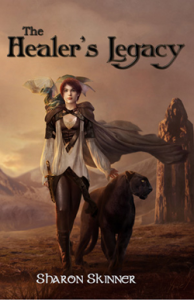Setting: Emotional Depth Through Character Perspective

When writing, I start from character, not simply because I think it’s a great place to start-although, for me, it’s mostly character engagement that keeps me reading (or writing) a book or story-but more so because that’s just the way my brain works.
So, when describing the landscape/creating the setting for the book, everything I see is filtered through the eyes of my characters. This is a huge plus in developing voice and for showing the character's emotional journey, because the world the reader sees is from the perspective of the characters living in and experiencing it.


Setting in The Healer’s Legacy and The Matriarch’s Devise:
There were a few things I knew about Kira’s world before I set foot in it. As soon as she manifested in my mind, I knew some of the issues she faced, as well as some of the major parameters of her environment.
- There are small “magics” at work in Kira’s home realm, but only a few individuals are “touched” by them.
- The technology is primitive. Fire. Swords. Herbology.
- The fauna includes mythical animals, such as the miniature wyvern she travels with, while some animals are similar to our world, such as horses and large felines.
- The social structure in the first book is not only patriarchal, but also one with a social hierarchy in which status is determined by bloodline and gender.
Other than this, I knew only what Kira decided to share with me as she shared it.
For example, the first place we see in Kira’s story is the weather-worn home of her mentor, the healer, Heresta. This is the place where Kira, having been orphaned during the war, grew up. Just like first time readers of The Healer’s Legacy, I have never seen this small healer’s home from any perspective but Kira’s. Therefore, it appears even smaller than it probably is. Homes always do when we have been way for a time and then returned.
The description of the hut, with its cracked weathered walls and thatched roof with bare patches resonate with Kira’s own sadness and reflect the state of her relationship with the woman who raised her. “The yard in front of the cottage was also withered. The plot of herbs that had once grown bright and green, now a barren space of dirt spotted with weeds.” This metaphorical image of the relationship between Kira and her mentor was not consciously derived, but grew organically out of seeing the world through Kira’s eyes, and filtered by her emotional lens. This sort of emotional nuance brings a deeper meaning to story without overtly pointing it out. Not every reader will make the conscious connection here, but the description colors the world with tints and hues that convey meaning directly to the subconscious. It’s like the backlights on the television series Face-Off, which are typically purple or blue, changing to red as the competitors step onto the “chopping block” to hear which one will be eliminated. Though it happens without fanfare, the lights fading to red (a color that is subconsciously upsetting to most people), signals something bad is happening.
In fiction, the right word choice and/or turn of phrase, even when used to describe an element of the environment can provide that emotional nuance, and can elevate setting to act as a character in the story. So, whether you build from character and layer in plot, or plot first and then add character arc, seeing the world through your character’s eyes is critical in getting the right flavor and emotional nuance across to the reader.